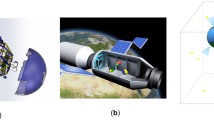Abstract
This study focuses on a least-squares framework suitable for spacecraft onboard computing in the visual 3D reconstruction of a rotating target, such as asteroids or space debris. During a proximity mission, recognizing the motion and shape of a target is crucial to touchdown on it or seize it before starting the actual operation. The 3D reconstruction of objects from 2D images, or bundle adjustment, has been intensively studied in the field of computer vision. Most algorithms involve nonlinear optimization and are computationally expensive; therefore, they require high-performance computers on the ground to obtain a solution. However, a strong demand exists for lightweight algorithms that can be operated on onboard computers to reduce spacecraft–ground communication delays. We analyzed the 3D reconstruction problem and formulated it as an overdetermined system of linear equations. We solved these by applying least-square solutions. Linear approximation is justified under the unique circumstances of the space environment, that is, no friction exists with air or other objects, and hence the motion is considerably simple in the absence of an external force. The least-squares framework requires only matrix calculations, and its computational complexity is considerably less than that of conventional algorithms. The simulation results demonstrate the accuracy of the 3D reconstruction acquired by our method.
Access this chapter
Tax calculation will be finalised at checkout
Purchases are for personal use only
Similar content being viewed by others
Notes
- 1.
If an SC is below the horizon and is not visible from an antenna, we must wait communication restoration until the earth’s rotation makes it visible.
- 2.
Refer 3.1 for visibility of GCPs.
References
Asteroid Itokawa 3D Model | NASA Solar System Exploration. https://solarsystem.nasa.gov/resources/2377/asteroid-itokawa-3d-model/. Accessed 27 Jun 2022
Maruya M (2020) 3D reconstruction of asteroid Ryugu as an inverse problem. In: New technologies for non-destructive and non-invasive inspections and their applications (ISSN 2188-286X)
Maruya M et al (2006) Navigation shape and surface topography model of Itokawa. In: Collection of technical papers—AIAA/AAS astrodynamics specialist conference, 2006, vol 3, pp 1522–1540. https://doi.org/10.2514/6.2006-6659
numpy.linalg.svd—NumPy v1.23 Manual. https://numpy.org/doc/stable/reference/generated/numpy.linalg.svd.html. Accessed 26 Jun 2022
Pesce V, Agha-Mohammadi AA, Lavagna M (2018) Autonomous navigation & mapping of small bodies. In: IEEE Aerospace conference proceed-ings, vol 2018-March, pp 1–10, Jun 2018. https://doi.org/10.1109/AERO.2018.8396797
Takiguchi T (2020) A theoretical study of the algorithm to practicalize CT by G. N. Hounsfield and its applications. Jpn J Ind Appl Math 37(1):115–130. https://doi.org/10.1007/s13160-019-00391-1
Triggs B, McLauchlan PF, Hartley RI, Fitzgibbon AW (2000) Bundle adjustment—A modern synthesis. Lecture Notes in Computer Science (including Subseries Lecture Notes in Artificial Intelligence and Lecture Notes in Bioinformatics) 1883:298–372. https://doi.org/10.1007/3-540-44480-7_21
Author information
Authors and Affiliations
Corresponding author
Editor information
Editors and Affiliations
Rights and permissions
Copyright information
© 2023 The Author(s), under exclusive license to Springer Nature Singapore Pte Ltd.
About this paper
Cite this paper
Maruya, M., Takiguchi, T. (2023). Visual 3D Reconstruction of a Rotating Object in Space Environment with a Least-Squares Framework. In: TAKIGUCHI, T., OHE, T., Cheng, J., HUA, C. (eds) Practical Inverse Problems and Their Prospects. PIPTP 2022. Mathematics for Industry, vol 37. Springer, Singapore. https://doi.org/10.1007/978-981-99-2408-0_9
Download citation
DOI: https://doi.org/10.1007/978-981-99-2408-0_9
Published:
Publisher Name: Springer, Singapore
Print ISBN: 978-981-99-2407-3
Online ISBN: 978-981-99-2408-0
eBook Packages: EngineeringEngineering (R0)




